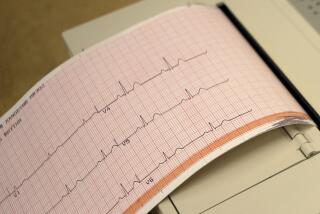The Countless Ways Doctors Measure Health
- Share via
Some folks collect stamps. Others collect baseball cards.
Dr. John Svirbely and M.G. Sriram are passionate collectors, too--of “medical algorithms.” For years, they’ve enthusiastically amassed the many mathematical calculators, scales and flowcharts that doctors use to help figure out things like a patient’s body mass index, how tall a kid is likely to be as an adult or the severity of a case of yellow toenail.
Svirbely, a pathologist at McCullough-Hyde Memorial Hospital in Oxford, Ohio, and Sriram, a San Francisco computer scientist, have thousands of these handy tools compiled in a giant database that can be found at www.medal.org. It wasn’t meant to get so big: “When we started off,” Svirbely says, “we thought there would be a couple of hundred. But I never cease to be amazed at how many there are once you start looking.”
There are tools for deciding if someone’s tongue is oversized. There are systematic methods for identifying ticks, parasitic worms and “arthropods of medical importance.” Ways to calculate--with a click of a button--how much blood a particular patient can afford to lose, if an injured limb is likely to recover, or how much oxygen someone is likely to consume while walking, running or stepping.
The fruits of hours spent surfing the Internet, thumbing through medical journals and leafing through textbooks is far-ranging: calculators and scales for seemingly everything a doctor could want to assess a patient, from foot (“Grading of a Lateral Ankle Sprain”) to face (“Clinical Score for Acne Scarring”) and in between (“A Practical Score for the Early Diagnosis of Acute Appendicitis”).
Has the Guinness Book of Records been informed? That, says Svirbely, is not the point. The aim is to build a sort of one-stop shopping resource for doctors who need, for example, to calculate a drug dose for a patient or figure out what’s crawling in his or her hair. This, he says, could help cut down on medical errors--and make it easier for doctors to use all the calculators and scales languishing in the literature.
Some of them probably should languish, Svirbely concedes. “A forensic pathologist friend of mine laughed at some of the stuff I put in the forensic pathology chapter--he said no one who’s a practicing pathologist uses them.”
Many of the measures, however, are commonly used. For instance, Dr. William K. Averill, a Torrance cardiologist and American Heart Assn. spokesman, says cardiologists often use body-surface-area calculations to figure out if someone’s heart is pumping as much blood as his or her body requires.
The origins of the body-surface calculations illustrate how much effort people put into creating all these algorithms. Body surface calculations come from a string of experiments from 1916 onward in which intrepid investigators did things like wrap cadavers and people in sticky paper or foil, then measured how much it took to cover them. Because covering patients in sticky paper is not clinically practical, they figured out math that related the surface areas they found to the height and weight of the bodies.
Medical calculators and other algorithms can be really useful, says Dr. David Schriger, professor of emergency medicine at UCLA. He’s devised one himself to track needle-stick incidents for hospital staffers. You tap in info such as the type of needle, type of injury, source of contamination and health of the victim and get advice as to how to proceed.
“The CDC publishes a book roughly 80 pages long that describes how to manage this, but who’s going to read the book and remember it all, or have time to read it when they need it?” Schriger says.
On the other hand, doctors have to remember that medical algorithms aren’t perfect, he says. And doctors can’t go nuts looking everything up. “If I had to check every fact for every patient, people would be dying out there waiting to see me,” he says. “Chaos isn’t good--but neither is regimentation. You have to learn to live in the middle.”
*
If you have an idea for a Booster Shots topic, write or e-mail Rosie Mestel at the Los Angeles Times, 202 W. 1st. St., Los Angeles, CA 90012, rosie.mestel@latimes.com.






